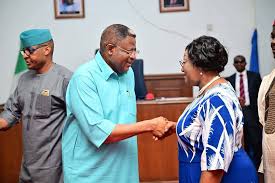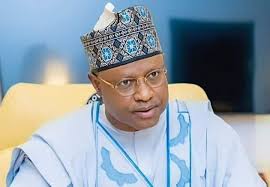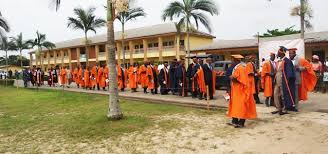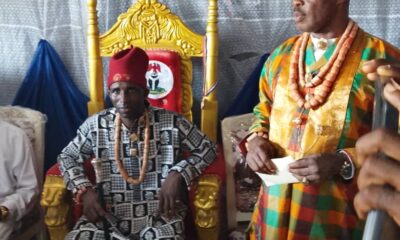Education
When Journalism Takes A Vindictive Turn: This Day Against Wike
One has watched in amazement, amusement and at the same time, horror, at how ThisDay, a Nigerian national newspaper, in over the past few years, somehow has led a campaign of attacks to besmirch, blacklist and denigrate the erstwhile governor of Rivers State, Nyesom Wike. They have gone about this in various ways: in a series of negatively scathing articles, opinion pieces and editorials; no coverage of the many positive achievements Wike has in his coffers, in Rivers State and nationally; refusal to publish submitted articles touting Wike; and many oral yellow journalistic swipes in other media.
Most of these attacks were during Wike’s tenure as governor. One begins to wonder the root cause of this consistent blitzkrieg against Wike. He was governor of Rivers State, and hence in the Executive arm of government and ThisDay is a member of the Fourth Estate. Wike is primarily charged with running the affairs of a state and ThisDay is to dispassionately inform the public as to events surrounding government workings and how they impact on their daily and future lives.This Free Press has come to take on the role of educating and influencing public opinion on political issues and activities of government: the whole three tiers. This, in essence, is the pinnacle of the continually evolving ancient dictum that “No one is beyond the law”, including Wike. Granted that this is the case, the lopsided and very misleading and unbalanced reporting by ThisDay on Wike does not fit this billing. What we have here is a crucifixion. It is very disturbing, troubling; and ought to stop.
Wike became governor of Rivers State under the PDP political party and before this, he was a two-term chairman of Obio/Akpor LGA. As governor, he had to be judged on how well he governed the state. Like for any political office holder, there are those that say he did very well and there are also those that disagree, and say he did not do well. As we know, one of the ways this divide is tested is during elections. Wike ran for a second gubernatorial term and won, which will tend to give a pass mark to his governance; so he served two terms as governor. He also supported a candidate for the 2023 governorship elections, in the name of Sim Fubara, who won. This also, is a testimonial pass mark to Wike’s second tenure performance from the simple truism that you cannot win where you are not liked. In fact, Wike is considered a hero and champion of a great majority of Rivers State constituents; he has done rather very well by them.
ThisDay as a national daily newspaper and member of the fourth estate – so called as if to say, the fourth arm of government – is charged with oversight function over the formal de facto three tiers of government reportage. This fourth estate or the free press has evolved over many centuries of grappling with developmental parallels of governmental Social Contract philosophies for its practitioners to now also be tagged ideologically either to the Left (Liberals) or to the Right (Conservatives). The dividing themes cover such societal issues that include: whether there should be more or less government participation in an economy; women rights; abortion rights; military spending; capital punishment; right to bear arms; warring tendencies (doves and hawks); welfarism; isolationism; LGBTQ; religious secularism; etc. Hence political ideologies in developed nations (who ThisDay writers keep referencing) are known to be to the Left or Right and these ideologies are embodied in their political party constitutions, manifestos and practice. Accordingly also, their press has also taken on similar ideological positions: some are liberal and others are conservative in their biases.
The critical question now is to ask if there is a similar ideological divide in Nigeria. Or are there perhaps other societal issues that contribute towards an ideological divide? If so, what are they? Frequently recurring possible bases for a dividing line are issues deriving from ethnicity (the various ethnic groups), regionalism (North, South, East, West, the zones), religion (Christianity, Islam, animism), transparency, etc. As it turns out, these have not impacted the ideology of major political parties in Nigeria such as PDP and APC and as such, have not given birth to any strong ideological dichotomy. In fact, going by this Fourth Republic, one can argue that there are no discernable ideological differences in the political parties: for one, there has been such smooth, seamless and massive inter-party crossovers among members – from governors, senators to house of representatives members – that one has to step back to constantly remind oneself what political party any particular politician currently belongs to.
With no ideological base one cannot say ThisDay is to the Left or to the Right. What It appears to be is a paper that heaps personal attacks – not on policy – on those they dislike (Wike) and probably extol those they like, for whatever reason. These scathing attacks have continued even long after Wike has successfully handed over his reign to his successor in the state. The attacks have now followed Wike to the national theater where it is about Tinubu and the National Assembly: Tinubu is in the midst of picking his helmsmen (ministers, advisers, heads of MDAs) and the National Assembly is in a tussle over picking its leaders and committees. Thus, Abuja as of today is a hotbed of political activities – lobbying, meetings, negotiations, alignments, etc. – for these positions. The atmosphere is rife with rumors, innuendos and even outright accusations that Wike is desperately hunting for a ministerial slot. For this reason, ThisDay has found it fit to up the barrage of attacks, as if to ensure Wike fails in his pupported quest. ThisDay has suddenly become the gatekeeper for APC, so that Wike should not be allowed in as if there are any ideological differences between APC and PDP; many major players in APC were erstwhile PDP members, even some with double flips (Atiku). They even forget that Wike was a one time minister of education under President Goodluck Jonathan, where under his stewardship, he among other things, effectively oversaw the construction of many amajari schools in the North; N15b worth.
An entry into these attacks is typified in a most recent article by one Chidi Amuta titled, “The Ministers Tinubu does NOT Need” published in ThisDayLive:
https://www.thisdaylive.com/index.php/2023/07/02/the-ministers-tinubu-does-not-need
In their typical attacking subterfuge, like this one, even the title is misleading: the only minister – not “ministers” – mentioned by name is Wike; it was all about Wike and no one else. Thus the correct title actually should be “Wike, the Minister Tinubu does NOT Need”. It contains so many falsehoods about Wike. Incidentally, aligning and agreeing with this attack is Tunde Olusunle, an Atiku apologist, who also in a similar fashion derogatively refers to Wike in an article as “A New Janitor in Aso Villa”, in TheCable. Amuta and Olusunle have intersecting interests at TheCable. There is also the Tambuwal and Northern apologist, Dahiru Maishanu, who in a recent ThisDay article, “Wike’s Latest Show of Rambunctious Politics of Bitterness, Vendetta”, berates Wike for even daring to support a candidate for the Senate Minority Leadership. The attacks are relentless.
Amuta is a known Amaechi and APC apologist, having written Amaechi’s biography. We are all too aware of the feuds between Wike and both Atiku and Amaechi. Can these perhaps be the reason for the relentless attacks on Wike? Is ThisDay pro-Atiku, pro-Amaechi and/or pro-APC? Thus, it appears that the role of ThisDay is to forment and propagate anti-Wike sentiments across media houses. Even in Amuta’s referencing of the US politicking in this article, he does not even speak to the deep-rooted ideological divide between the left Democratic Party and the right Republican Party; instead it is an anti-Trump and pro-Biden slant. Thus, here again, he fails to see that these presidents have significantly large followerships, with the US swinging in either direction at any one time. In a similar vein, he should also know that Wike does have a significantly large followership.
The most appalling aspect of these articles is that they are purely ad hominem attacks of Wike, and not about his political convictions and policies. They refer to his alleged drinking; disloyalties to Amaechi, Atiku and PDP; his one-time badly buttoned jacket; his random hobnobbing; his use of the state jets; his husky voice; a creek boy; rabble rouser; noise maker; uncouth mannerisms; exhibitionism; a national nuisance; political rascality; jealousy; and it goes on.
But what are Wike’s policies? What does his scorecard in Rivers State show? What are his political views? What is his thinking on the regional North-South political divide? Does he believe in equity and fairness? What are his thoughts on the peculiar local Rivers State upland and riverine (Ijaw) dichotomy? What are his economic policies? What are his health, education, agriculture and environment policies? What role did he play in curbing Covid-19 in Rivers State? Are there any infrastructural developments to his credit? In fact, ThisDay is usually mute on these topics. It just about knows nothing or says anything about these; it is just an open season of yellow journalism and plain old-fashioned mudslinging.
Granted, Wike, like many governors, is nowhere near perfection (not an excuse). First off, his sometimes abrasive, confrontational and combative style is a behavior some consider undiplomatic. There are those that think along these following lines that: he was thin on macroeconomic policies for the state; many of his infrastructural developments were skewed towards his native LGAs; there was high insecurity (cultism, kidnappings, robbery) at certain times that impacted negatively on economic development; there are others. But what are his known accomplishments?
Perhaps, it is now time we highlighted some of these for a balance. As a guide, it is important to remember a very important, demonstrable and recurring philosophy of Wike, which is “Fairness and Equity”. This is what informs and explains many of his policies and decisions.
Take Port Harcourt for instance. It is cosmopolitan, the state capital and the nerve center of Rivers State: industrial, commercial and social life. It is the seat of two large LGAs and directly impacts life in six other adjoining LGAs. Over half the residents of the state live in these LGAs. It used to be a nightmarish traffic impasse for residents, transients and visitors. Wike, quite aware as to the importance of this city, in a stroke of genius, has drastically eased this. It is now actually a thing of pleasure zooming through Port Harcourt. He did this with: his over 12 flyovers; bypass roads; bridges; expanded roads; and many reconstructed and renovated internal road networks. The City of Port Harcourt has finally been transformed into the true metropolis that is her befitting status.
There are also commuter roads – either completed or still under active construction – radiating out of Port Harcourt to towns in farther LGAs like Khana, Bonny, Opobo, Etche, Kalahari LGAs, Oyigbo and others. Internal road networks have also been upgraded in other LGAs.
Nwokogba is President of Etche Heritage Foundation.
Port Harcourt.
He has built, renovated, upgraded and refurbished over 175 schools; partnered with the DISCO PHED to improve power supply to the state; built the Dr. Peter Odili Cancer and Cardiology Center; established theDr. Nabo Graham Douglas campus of Nigerian Law School campus (N17b); he has built, renovated and rehabilitated many buildings of the judiciary infrastructure; established many campuses of Rivers State University; the infrastructural list is endless. He has been fair in the state-wide distribution of these projects. His conceptual Ring Road project spanning six LGAs is still ongoing under his successor governor, Sim Fubara, ushering in a much desired continuity in infrastructural development in the state; Kudos to Fubara. These have earned Wike the affectionate and endearing title, Mr. Project. By all these, Rivers State residents acknowledge seeing their money working for them.
It is in his political dimension that one clearly sees where his fair and equity doctrine undeniably plays out: what is good for the goose is good for the gander. Locally, he has been very insistent in directing his party, the PDP, towards adopting a balanced political fairness play in the mosaic of multi-ethnic hubris, typical of the Niger Delta. Nationally, he has staked his position against the lopsided overloading of PDP top party positions to the North.
In Rivers State, the Ijaws constitute almost half the total LGAs and since the inception of the Fourth Republic, all the governors (4 of them, 6 terms) have come from the upland (non-Ijaw) zones, hence PDP this time, for fairness sake, zoned it not only to the riverine Ijaws but to the part that had never produced a governor since Rivers State existence. In the East Senatorial District, PDP had also zoned the slot to the ethnic Etche people, who share this zone with the Ikwerres and the Okrikans who have been taking turns to this senate seat to the detrimental exclusion of Etche people. Incidentally, Wike is Ikwerre – and not from the creeks as ThisDay would want us to believe – from this senatorial zone and could have easily requested for this seat after the unsuccessful bid for the presidency, like others did. But he was resolute in respecting the zoning to Etche; fair is fair. PDP adopted this fairness doctrine across the board in their zoning formulae for the houses of representatives and state assembly. By so doing, all parties adopted the PDP pace-setting zoning formula in the state.
Nationally, PDP was actively run and managed by Wike in the absence of players like Atiku who has been away at his adopted second home, Dubai. PDP had three top major northern party leaders – the Presidential flag bearer (Atiku), the national chairman (Ayu) and the BoT chairman (Jibrin) – as if the South had no share in it. The PDP case completely disregarded the fact that the then President was a Northerner, raising the specter of a consecutive North-North Presidency. There has been a strong clamoring for the South, particularly the Southeast (Ibos) to produce the next Nigerian President, having never produced one since as far back as the Second Republic.
It is not surprising then, that Governor Wike then transited from a presidential bid to becoming a champion fighting for equity for the South. Governor Wike, as admitted by all, had kept PDP alive after the exit of President Jonathan. Why was he not considered the national PDP Leader and treated as such? Having lost (or robbed of) his Presidential bid by the North, why was he not center-stage directing the affairs of PDP? Why was he not accorded the right of first refusal for the vice presidential slot? Is there a master-slave relationship at play here? Where is the sensitivity, fairness and equity in all of this, one would ask.
As great men do, Governor Wike was left with no choice but to fight back. As it stands now, he was not a lone voice in PDP seeking equitable share for the South. He garnered the support of some major party stakeholders that included four PDP state governors, now dubbed the G5; there are definitely silent supporters. With at least 5 (of 16) known PDP states on one side, PDP stood the risk of losing the Presidential slot if these discordant tones were not resolved. Finally, PDP lost but at least now, we take solace in the fact the Presidency is in the South. So, for Wike, it was never really about being against Atiku, Ayu, Tambuwal or PDP, it has always been about fairness and equity. The party issue is secondary and besides, as argued earlier, these parties do not really have any different political ideologies.
On a lighter note, there is a local 2-line stanza piece that now resonates locally and nationally, that captures this essence of fairness and equity that was coined by Wike: “Enye ndi éba, Enye ndi éba”. This is accompanied by a metronomic hand motion pointing first left, then right. The meaning being that if you must give to Peter, you then next must give to Paul; power should rotate. It is his sense of fairness and equity that has endeared many people (including me) to him; I am now a Wike apologist and supporter trying to portray a balanced view. It is this ideological prism that ThisDay should use to understand Wike so as to give a balanced perspective in its approach. ThisDay and the Fourth Estate should also help in defining and advancing ideological themes that will promote good governance, in a bid to help fulfill the ever intricate and evolving Social Contract prescription.
Finally, we should also acknowledge and remember that Wike’s abrasive and combative mein hides a very intelligent and astute person. Going forward for now, it will be prudent to watch Wike’s space, accord him his well deserved respect, and remember his name: His Excellency Chief Barrister Ezenwo Nyesom Wike, CON.
By: Acho Nwokogba
Education
Otu Inaugurates UNICROSS, UEE’s Governing Councils

Cross River State Governor, Bassey Otu has inaugurated the newly constituted Governing Councils of the University of Cross River State (UNICROSS) and the University of Education and Entrepreneurship (UEE), Akamkpa.
At the ceremony on Thursday in Calabar, the Governor urged the members to drive institutional excellence, ensure accountability, and align with global best practices.
Governor Otu acknowledged that UNICROSS had long suffered from what many perceived as gross neglect, particularly in terms of physical development.
“After a deep thought and consultation, and having considered all available facts and evidence, I am today opening a new chapter in the relationship between government and its institutions of higher education,” the Governor declared.
He emphasised that while his administration is committed to a renewed focus on higher education, this attention must be matched with transparency and responsibility by the universities’ management.
The same expectation, he said, applies to the University of Education and Entrepreneurship in Akamkpa.
Governor Otu stated that the appointments into both councils and management were carefully considered and reflect the state’s finest minds and seasoned professionals.
“I have taken pains in appointing some of the best that the State has in both the Governing Councils and Management of the institutions. I implore you to apply your wealth of experience in making the institutions world-class,” he charged.
He also stressed the importance of respecting the distinct roles of Councils and management, pointing out that most university problems emanate from role conflict or interference. He tasked each of the councils to stick strictly to its clearly defined functions.
The Governor encouraged council members to leverage their networks to attract new sources of funding and value to their institutions.
“Do not limit yourselves to already known threads of resource sources.”, he said.
Education
Kaduna Cuts Tertiary Tuition Fees By 50%

Governor Uba Sani of Kaduna State has announced a 50 percent reduction in tuition fees for all Kaduna State-owned tertiary institutions, describing it as a major step toward removing barriers to higher education.
Speaking through his Principal Private Secretary, Professor Bello Ayuba, at the inauguration of the Kaduna State University Chapter of the Kaduna State Students Union, the Governor said the policy has made it easier for students from low-income backgrounds to pursue university education in the state.
He expressed gratitude to the students for presenting him with the Sword of Honour Award and for recognising the achievements of his administration, which were highlighted during the event’s public lecture.
He promised, “Government will continue to support students and the youth generally to realize their ambitions. On your part, make sure that an atmosphere of peace prevails to allow for government’s development programmes to run their full course.’’
The Governor advised students not to allow agents of disunity and chaos to use them to destabilize their communities and steer them away from their career goals.
Governor Sani reminded the students and lecturers at the event that ‘’no meaningful development can be achieved in a state of chaos, disunity and mutual mistrust.’’
However, he said that ‘’going by your conduct over the period that I have been at the helm of affairs of our state so far, you are reliable partners of progress and I can count on you every step of the way.’’
The governor recalled that Kaduna State was under siege owing to the insecurity in some of the local government areas, which had dire consequences on agricultural and business activities.
He noted that the security challenges have now been drastically reduced owing to the combined commitment of security agencies, resulting in safer high ways, people returning to farms and the opening of local markets.
120 Oldest Secondary Schools in Nigeria
The governor further said that the Birnin Gwari cattle market which had been closed for over 10 years, has been reopened, so have the other markets in security challenged areas in Giwa local government.
Education
Rivers Poly Matriculates 1, 882 Fresh Students

The management of Captain Elechi Amadi Polytechnic,Rumuola, Port Harcourt, Rivers State has admitted 1,882 fresh students to study various courses and programmes for the 2024)2024 academic session.
This announcement was made by the Rector of the polytechnic, Dr Moses Neebee during the 34th matriculation ceremony of the institution held in Port Harcourt over the weekend.
Dr Neebee described convocation as an annual rituals of every institution used to mark the end of admission process, adding that the polytechnic has recorded some academic milestones and achievements.
According to him, the institution recorded 100 percent in the just concluded NABTE accreditation and resources visitation exercise, adding that all the 24 courses presented by the institution during the accreditation were approved including the almighty Diploma in Law.
According to the admission statistics provided by the Rector,1,510 students were admitted for the National Diploma programmes ,while 372 students were offered admission into the Higher National Diploma and part programmes of the polytechnic.
The Rector while congratulating the matriculants urged them to take their studies seriously and ensure that they pass through the institution and as well allow the institution pass through them and not only in learning but also in character.
“ Let me congratulate you all for your successes to scale through the rigorous hurdles of our admission processes. Take advantage of the various technical and entrepreneur skills in the school to equip your self which will make yourselves employed and be better equipped in the society”, he said.
The Rector warned them to desist from any activities that will jeopardise their academic success, stressing that the school has zero tolerance for cultism, examination malpractices, sorting and sexual abuse.
He used the opportunity to thank the state government for the support given to the school especially in the areas of infrastructure development.
-
News2 days ago
Army Chief Gives Troops One Month Marching Order To Flush Out Bandits In Niger, Kwara
-

 Nation2 days ago
Nation2 days agoMonarch Preaches Peace As He Unveils Palace
-
Niger Delta2 days ago
Eno Promotes ARISE Coordinator To Perm Sec
-
Business2 days ago
Multipurpose Terminal Hosts 6,606-Foot Capacity Vessel In Onne
-
Politics2 days ago
Speakers Conference Tasks FG, Governors On Wanton Killings
-
News2 days ago
Court Okays Arrest, Detention Of Six CBEX Promoters
-

 Featured2 days ago
Featured2 days agoFG To Seize Retirees’ Property Over Unpaid Housing Loans
-
Niger Delta2 days ago
Diri Okays Ongoing Projects’ Progress

